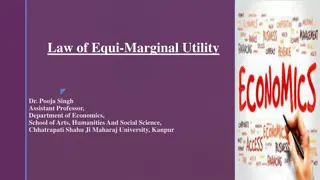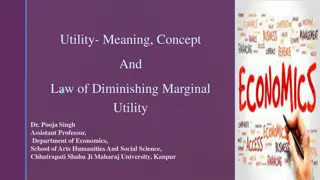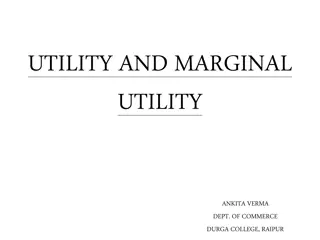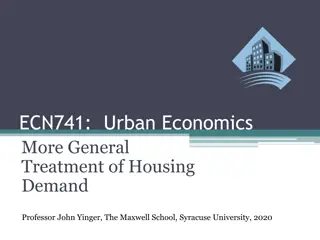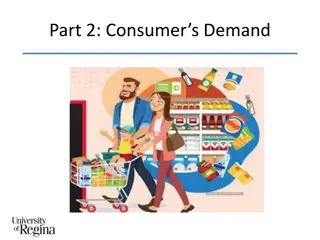
Cardinal and Ordinal Utility in Economics
Explore the concepts of cardinal and ordinal utility in economics, where cardinal numbers measure utility quantitatively and ordinal numbers rank preferences. Learn about the law of diminishing marginal utility and total utility to understand consumer behavior and satisfaction.
Download Presentation

Please find below an Image/Link to download the presentation.
The content on the website is provided AS IS for your information and personal use only. It may not be sold, licensed, or shared on other websites without obtaining consent from the author. If you encounter any issues during the download, it is possible that the publisher has removed the file from their server.
You are allowed to download the files provided on this website for personal or commercial use, subject to the condition that they are used lawfully. All files are the property of their respective owners.
The content on the website is provided AS IS for your information and personal use only. It may not be sold, licensed, or shared on other websites without obtaining consent from the author.
E N D
Presentation Transcript
Cardinal Utility: The numbers 1, 2, 3, 4 are cardinal numbers. For example the number 2 is twice the size of 1. In the same way, the number 4 is four times the size of number 1. Alfred Marshall developed cardinal utility analysis. According to cardinal approach, utility can be measured. Ordinal utility: The numbers 1st, 2nd, 3rd, and 4th, are ordinal numbers. These ordinal numbers are ranked or ordered. This ranking does not explain the actual size relation of the numbers. The second one might or might not be twice as big as the first one. Hicks and Allen used ordinal utility approach for analyzing the consumer behavior. This analysis is known as indifference curve analysis.
The want satisfying power contained in a good is said to be its utility. In economics the term utility is used to denote the satisfaction or welfare. Utility derived from a good are of different form such as 1) Form utility, 2) Place utility, 3) Time utility, and 4) Service utility.
It is a psychological fact that when a person acquires more and more units of the same commodity during a particular time, the utility he derives from the successive units will diminish. In other words, the additional satisfaction derived from the additional units of a commodity goes on decreasing. H.H Gossen was the first economist to explain the law of diminishing marginal utility, and the law of equi marginal utility in 1854. W.S Jevons named them as Gossen first and second laws of consumption (1871). In 1890 Marshall in his Principle of Economics developed this analysis in a refined manner 1. 2.
1. The law of diminishing marginal utility is based on the cardinal measurement of 2. Utility is measured in terms of money. The law assumes that the marginal utility of money is constant. 3. There should not be any time gap between the consumption of one unit and the other unit. 4. The units of the commodity are homogeneous. 5. The consumer is assumed to be a rational economic man. He has the knowledge about the market. utility.
Alfred Marshall defines the Law of Diminishing Marginal Utility as The additional benefit which a person derives from a given increase of his stock of a thing diminishes with every increase in the stock that he already has. In the words of K.E Boulding As a consumer increases the consumption of any one commodity, keeping constant the consumption of all other commodities the marginal utility of the variable commodity must eventually decline
Total Utility: Total utility means the total satisfaction attained by the consumer from all the units of a commodity taken together in the consumption of a certain thing at a time. Marginal Utility: Marginal utility is the additional utility obtains from an additional unit of any commodity consumed or acquired. It is measured the difference between the utility of the total units of stock of consumption of a given commodity and that of consuming one unit less in the stock considered. In symbolic terms: MUx = Tux - TUx-1
We can explain the law with the help of the table. In the table a consumer goes on increasing X goods, the additional utility derived from an additional X goods declining. The law is clear from the following table. We can observe that as the units of the commodity X is increase, the marginal utility derived from each success units tends to diminish. The total utility increases at diminishing rate till the 6th X . At that level total utility becomes maximum, and marginal utility is zero. After this level total utility declines and marginal utility becomes negative. Zero marginal utility implies the point of satiety which indicates the complete satisfaction of a given want. The law of diminishing marginal utility can also be represented diagrammatically through the marginal and total utility curves.
X Units Total Marginal Utility - 8 6 4 2 0 -2 The Law of Diminishing Marginal Utility 35 Utility 10 18 24 28 30 30 28 1 2 3 4 5 6 7 30 TUC 25 Total/Marginal Utilities 20 15 10 5 0 7MUC 1 2 3 4 5 6 -5 X goods
1.When total utility increases at diminishes rate, marginal utility diminishes. 2.When total utility is maximum, marginal utility becomes zero. 3.When total utility decreases, marginal utility becomes negative.
1. Useful to Finance Minister. 2. Basis for the theory of value. 3.Basis for the Demand and explains the negative slope of demand curve. 4.Determination of optimum consumption. 5. Useful in the distribution of wealth.
The law of equi marginal utility explains as to how a consumer distributes his limited income among various commodities He will spend his income in such away that the last rupee spent on each of the commodity gives him the same marginal utility. Therefore, this law is known as the Law of Equi-Marginal Utility. In order to get maximum satisfaction out of his limited income, the consumer carefully weighs the satisfaction obtained from each rupee that he spends. If he thinks that a rupee spent on one commodity has greater utility than spending it on another commodity, he will go on spend his money on the former till the satisfaction derived from the last rupee spent in the two cases equal . 3. 4.
1. The utility is cardinally measurable. 2. The marginal utility of money remains constant. 3. Consumer has a limited amount of income and he spends the entire amount. 4. The wants and habits of the consumer remain constant. 5. The consumer is rational. He tries to get maximum satisfaction. 6. The consumer spends his income in small quantities while purchasing the commodities.
The law of equi-marginal utility has been stated by Marshall as follows If a person has a thing which can be put to several uses, he will distribute it among the uses in such a way that it has the same marginal utility in all . The law can be explained with the help of a numerical example suppose a consumer has Rs 5/- which he wants to spend on two types of commodities namely X and Y so that he obtains maximum utility. The following table shows the marginal utilities of successive rupees of income when spends on X and Y.
Units Mux Muy 1 10(1) 8 (2) consumer starts spending his first rupee on X because the highest marginal utility on X is 10 utils. In the same way he spends his 2nd, 3rd, 4th and 5th rupee on the commodities which gives highest utility. Thus the total utility obtain from X and Y will be 38, i.e. from X (10+8+6=24) and from Y (8+6=14). In this way the consumer spends his entire income on X and Y in such way that the last rupee spent on X and Y gives the same marginal utility. Thus the consumer gets maximum satisfaction 2 8 (3) 6 (4) 3 6 (5) 4 4 4 2 5 2 0 Total 30 20
Money expenditure and quantity of demand is shown on X axis and the marginal utility 1 2 derived from the commodities X and Y is shown on Y axis. Marginal utility of X is shown by the curve MUx, and marginal utility of Y is shown by the Marginal utilities commodities are equal The consumer is in equilibrium by purchasing the units of X and 2 units of Y as he obtains the maximum total utility at that purchase. 1 0 8 M a r g i n a lUtility 6 curve MUy. both at 6 utils. of the 4 2 mux muy combination of 3 0 1 2 3 4 5 Q u a n t i t y o fc o m m o d i t i e s
1.The law explains as to how a consumer maximizes his satisfaction from his limited recourses. 2.Optimum allocation of the recourses can be possible by applying this principle. 3.While imposing taxes, the government is cautious that the marginal sacrifice of all the taxpayers is the same. 4.The law guides an individual in the allocation of his time between work and leisure .
The concept of consumer surplus originally devised by Dupuit a French engineer in his paper On the measurement of public works in 1844. Marshall introduced Dupuit s relative utility concept as Consumer s Rent in his Pure theory of Domestic values in 1879. Marshall named it as consumer s surplus in the third edition of Principles of Economics in 1895. 1. 2. 3.
The price which a consumer pays for a commodity is always less than what he is willing pay for it, so that the satisfaction which he gets from its purchase is more than the price paid for it and thus he derives a surplus satisfaction which Marshall calls Consumer s Surplus. Instances of commodities from which we derive consumer s surplus in our daily life are salt, news papers, postcard, matches, etc. consumer s surplus can be defined as the difference between what a consumer is willing to pay for a commodity and what he actually does pay for it.
X units Price willing to pay Actual price Consumer Surplus 1 10 4 6 2 8 4 4 3 6 4 2 4 4 4 0 Total 28 16 12
Consumers surplus is represented diagrammatically in figure DD is the demand curve for the commodity. If OP is the price, OQ units of the commodity are purchased and the price paid is OQ X OP= area OQRP. But the total amount of money, he is prepared to pay for OQ units is OQRD. Therefore, Consumer s Surplus= OQRD-OQRP=DPR. D R P D O Q
Germany statistician Ernet Engle studied many house holds incomes and budgets and revealed relation between income level and spending on the consumption of some goods , at a given price. He proposed three important points in his study. When income increases the expenditure proportion on food items will decreases 3. When income increases the expenditure proportion on house facilities and cloths items will constant When income increases the expenditure proportion on education, health and entertainment items will increases. 5. 6.




